Overview
Understanding the importance of calculating operating income is crucial for small business owners, as it sheds light on profitability derived from core operations. This clarity enables better financial decision-making and enhances operational efficiency. Furthermore, accurately assessing operating income allows owners to pinpoint cost-saving opportunities and attract potential investors. This means that by focusing on these aspects, they can foster sustainable growth and ensure their financial health.
Introduction
In the competitive landscape of small business, it is crucial to recognize the nuances of operating income for achieving success. This metric, which reflects the profit generated from core business operations, offers invaluable insights into a company's financial health and operational efficiency. As small business owners confront the challenges posed by fluctuating markets and rising expenses, understanding the importance of operating income can indeed be a game-changer.
Furthermore, with the right tools and strategies—such as those provided by innovative platforms like Kulud—entrepreneurs can streamline their financial management processes, optimize profitability, and ultimately secure a sustainable future.
This article explores the definition, calculation methods, key components, and common misconceptions surrounding operating income, equipping business owners with the essential knowledge needed to make informed decisions and drive growth.
Understanding Operating Income: Definition and Importance
Calculating operating income is essential for understanding the profit generated from a company's core activities, achieved by deducting operational expenses from gross revenue. This metric excludes non-operating revenue and costs, such as interest and taxes, making it a vital indicator of an organization's operational efficiency and overall economic health. For small enterprise owners, accurately calculating operating income is crucial; a higher operating profit signifies a more lucrative venture, which is key to attracting investors and securing funding.
In 2025, financial specialists emphasize that calculating operating income is more than just a number; it reflects the efficiency of a company's strategies. Industry experts note, "Calculating operating income is a crucial performance measure that aids small enterprise owners in pinpointing areas for enhancement and expansion."
Recent trends show that small enterprises are increasingly focusing on optimizing their revenue to boost profitability. A staggering statistic reveals that 82% of enterprises fail due to cash flow problems, underscoring the importance of maintaining a healthy revenue stream to ensure financial stability. Tools like Kulud can significantly assist in this process by streamlining invoice management and automating bank transaction matching, allowing owners to concentrate on their core operations.
Consider a small enterprise with a gross revenue of $500,000 and expenses totaling $300,000. The resulting revenue of $200,000 is not only critical for evaluating the company's performance over time but also serves as a foundation for strategic decision-making. This figure guides owners in identifying cost-saving opportunities and potential areas for investment.
With Kulud, users can easily request missing invoices, centralize their financial data, and collaborate with accountants or bookkeepers, further enhancing their ability to manage expenses effectively.
Practical instances illustrate the impact of calculating operating income on organizational efficiency. A case study titled 'Go From Small to Profitable' emphasizes how small enterprises that strategically focus on calculating operating income can significantly improve their survival rates and revenue potential. By concentrating on essential functions and enhancing their products, these companies demonstrate that calculating operating income can lead to financial independence.
Testimonials from users like Georgi Knyazhev, who reduced invoice collection time from three hours to just five minutes, showcase how Kulud's automated solutions revolutionize expense management for freelancers and small enterprises.
Moreover, calculating operating income is crucial for attracting investors. Investors often scrutinize this metric to assess a company's profitability and operational health. In 2025, it is evident that small enterprise owners who prioritize understanding and enhancing their revenue are better positioned to secure financing and expand their ventures.
Furthermore, it is important to recognize that small enterprises have generated 17.3 million net positions over the past 26 years, with 63% of new roles originating from these businesses. This statistic highlights the broader economic impact of small enterprises and the significance of earnings in that context.
In summary, calculating operating income is not merely a monetary statistic; it is a fundamental component of a small enterprise's strategy for success. By focusing on this metric and utilizing tools like Kulud to simplify expense management, owners can enhance their operational efficiency, improve economic health, and ultimately drive growth. Additionally, Kulud offers tiered pricing options, starting with a trial that allows processing of 20 invoices and receipts, making it a cost-effective solution for small business owners looking to optimize their financial management.
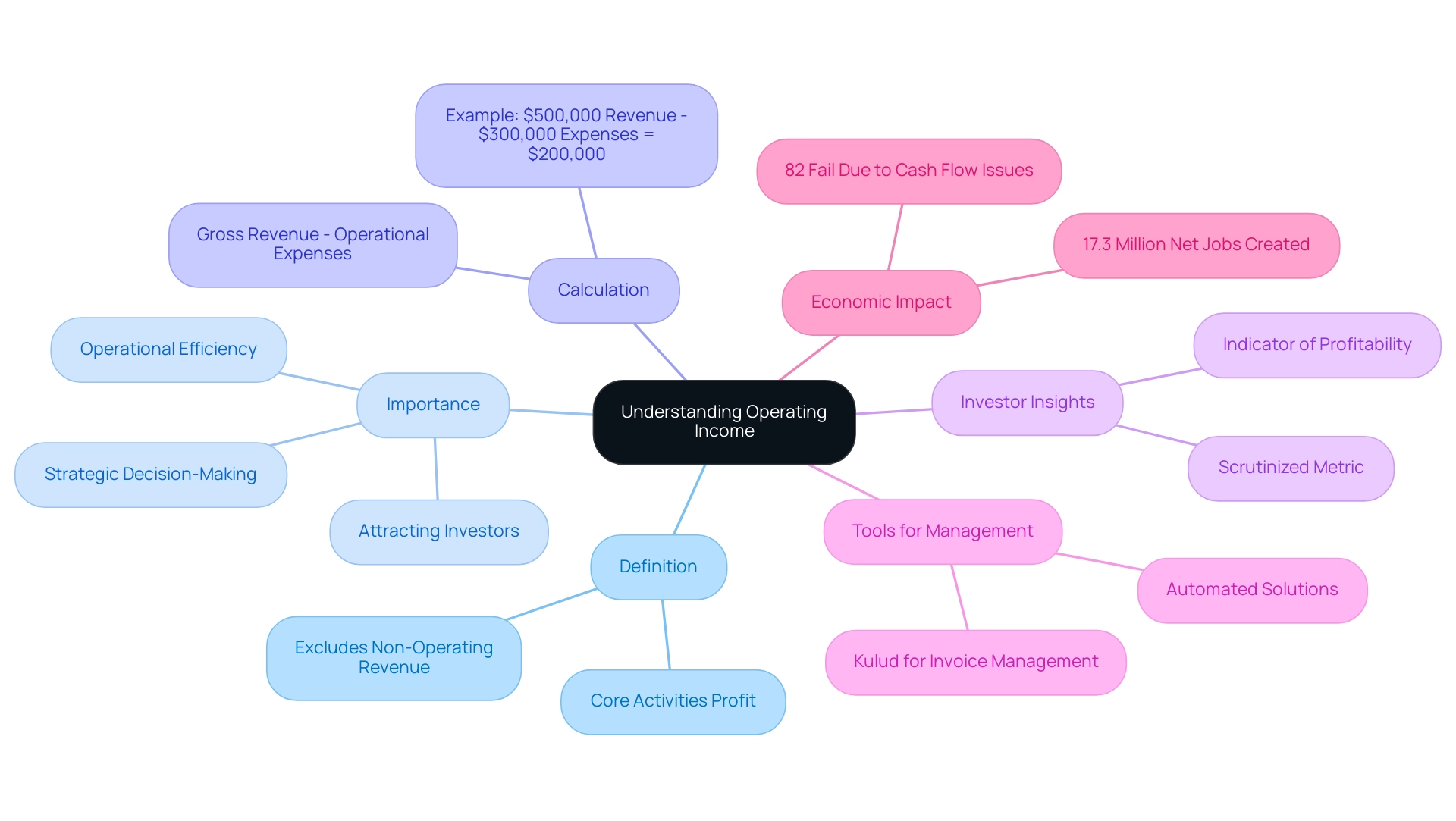
How to Calculate Operating Income: Step-by-Step Methods
To accurately calculate operating income, it is essential to follow a structured approach:
-
Determine Gross Income: Start by identifying your total revenue from sales or services. For instance, if your revenue from sales is $50,000, this figure will serve as your gross earnings.
-
Identify Operating Costs: Compile a comprehensive list of all operational expenses. This includes wages, rent, utilities, and the cost of goods sold (COGS). Understanding these expenses is crucial, as they directly impact your profitability.
-
Apply the Formula: Utilize the formula for operating income:
Operating Income = Gross Income - Operating Expenses
For example, if your gross income is $50,000 and your total operating expenses amount to $30,000, your operating income would be calculated as follows:
Operating Income = $50,000 - $30,000 = $20,000
This calculation provides clear insight into your business's profitability derived from core operations.
Freelancers often face challenges in accurately determining their earnings, particularly in 2025 where financial experts emphasize the importance of categorizing expenses to reflect true operational costs. This accuracy is essential, especially for those managing multiple revenue sources and varying expenses.
Furthermore, consider the average running costs for small enterprises in 2025, which have been reported to be around 60% of total earnings. This statistic underscores the necessity of careful expense monitoring to ensure precise financial calculations.
Moreover, testimonials indicate that small enterprises calculating operating income using systematic methods have experienced notable enhancements in clarity and decision-making. Georgi Knyazhev states, "Kulud has transformed my accounting processes, allowing me to save time and streamline communication with my accountants." This highlights the impact of utilizing automated expense management tools, like those offered by Kulud, which can streamline accounting processes, allowing businesses to focus on growth rather than administrative burdens.
With Kulud, freelancers can automate invoice processing, match expenses with bank transactions, and benefit from automated categorization of expenses, simplifying the entire oversight process. The platform enables users to effortlessly request missing invoices, review prior emails for receipts, and export reports in PDF format, ensuring that all data is accurate and up-to-date. Furthermore, Kulud has successfully completed a Cloud Application Security Assessment (CASA), enhancing its credibility and security for users.
In summary, calculating operating income is a fundamental aspect of fiscal management that can significantly impact an enterprise's strategic choices. By following these steps and leveraging modern tools like Kulud, freelancers and small enterprise owners can enhance their financial oversight and operational efficiency.
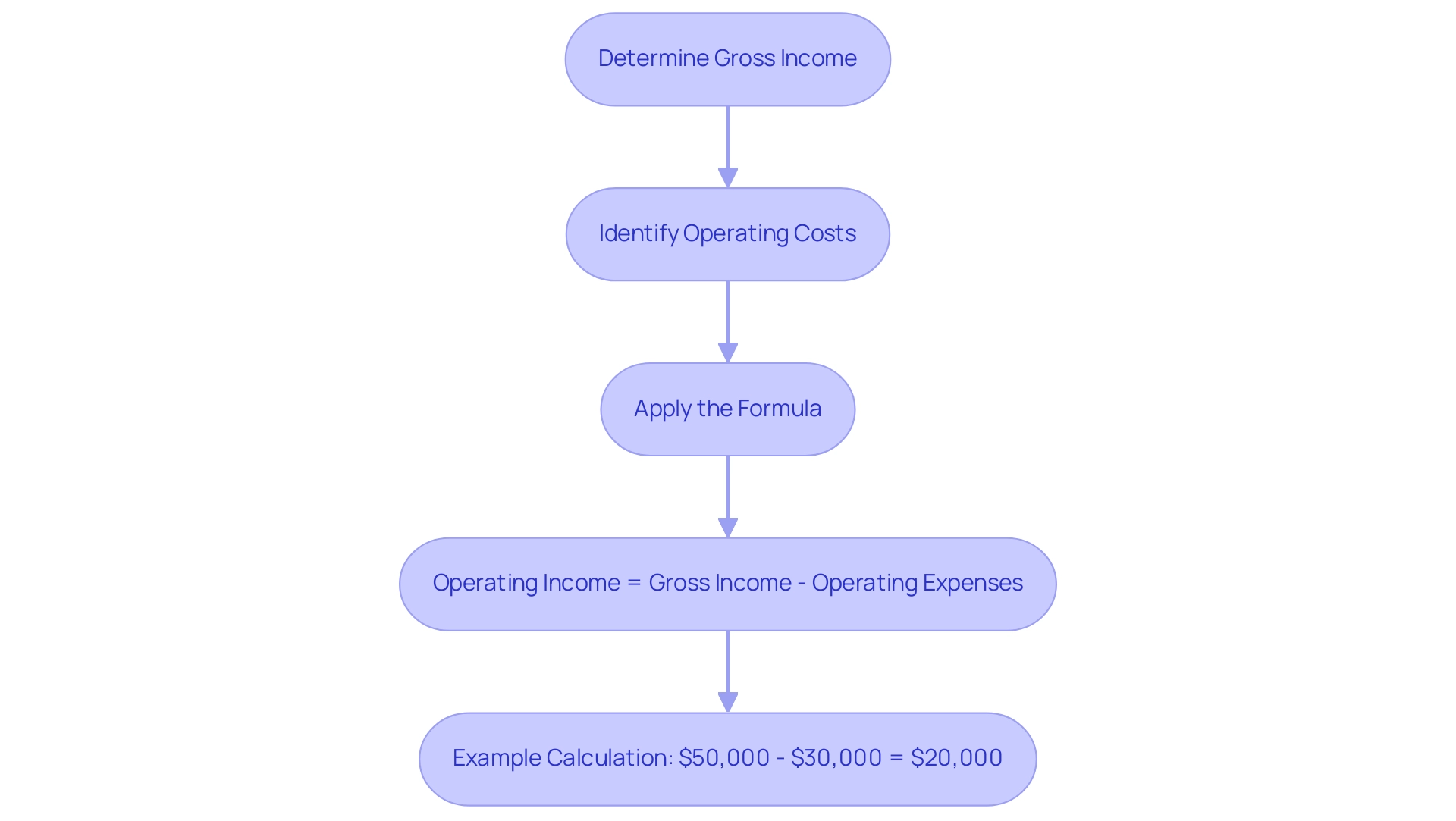
Key Components of Operating Income: Revenue and Expenses
Operating profit is a crucial measure of success for small enterprises, primarily comprising two key elements: revenue and operating expenses.
Revenue: This represents the total income generated from the sale of goods or services. For small enterprises, revenue is not just a figure; it is the lifeblood that drives growth and sustainability.
In 2025, small enterprise owners are encouraged to adopt innovative strategies to boost revenue, such as leveraging social media marketing, which has proven effective in brand discovery—78% of Gen Z consumers utilize these platforms for this purpose. Furthermore, small enterprises have generated 17.3 million net jobs over the last 26 years, with 63% of new positions originating from small enterprises, emphasizing their vital role in the economy. Enhancing marketing efforts and diversifying product lines can lead to significant increases in revenue, which is essential given that approximately 45% of small enterprises fail within the first five years due to inadequate capital and poor management.
Operating Expenses: These encompass the costs incurred during regular operations, including salaries, rent, utilities, and materials. Efficient management of expenses is essential for maximizing income. In 2025, small enterprise owners should conduct regular reviews of their expenses to pinpoint areas for potential cost reductions without compromising quality.
For instance, the typical operating costs for freelancers vary, necessitating careful monitoring of spending habits to enhance overall economic well-being. Significantly, small enterprise credit card balances have increased by 18% since 2019, highlighting the economic pressures that small owners encounter.
With Kulud's automated expense management system, freelancers can transform their bookkeeping from hours to minutes. The platform enables users to effortlessly request missing invoices and automate the matching of bank transactions, centralizing monetary data in one location. By signing in with their professional email and connecting their Gmail accounts, freelancers can simplify their expense management processes, making it easier to monitor and handle expenses effectively. Additionally, users can invite and collaborate with accountants or bookkeepers, enhancing their financial oversight.
The capability to choose date ranges and activate extraction features further streamlines the monitoring of expenses.
By comprehending and optimizing both revenue and expenses, small enterprise owners can significantly enhance their calculating operating income. Current statistics indicate that the average yearly salary for small enterprise owners in the US is $62,083, with 75% reporting satisfaction with their work. Financial analysts highlight that a strategic focus on these components, supported by tools like Kulud, can lead to sustainable growth and increased profitability for small enterprises in 2025.
Testimonials from users emphasize how Kulud has optimized their processes, enabling them to concentrate more on their primary activities.
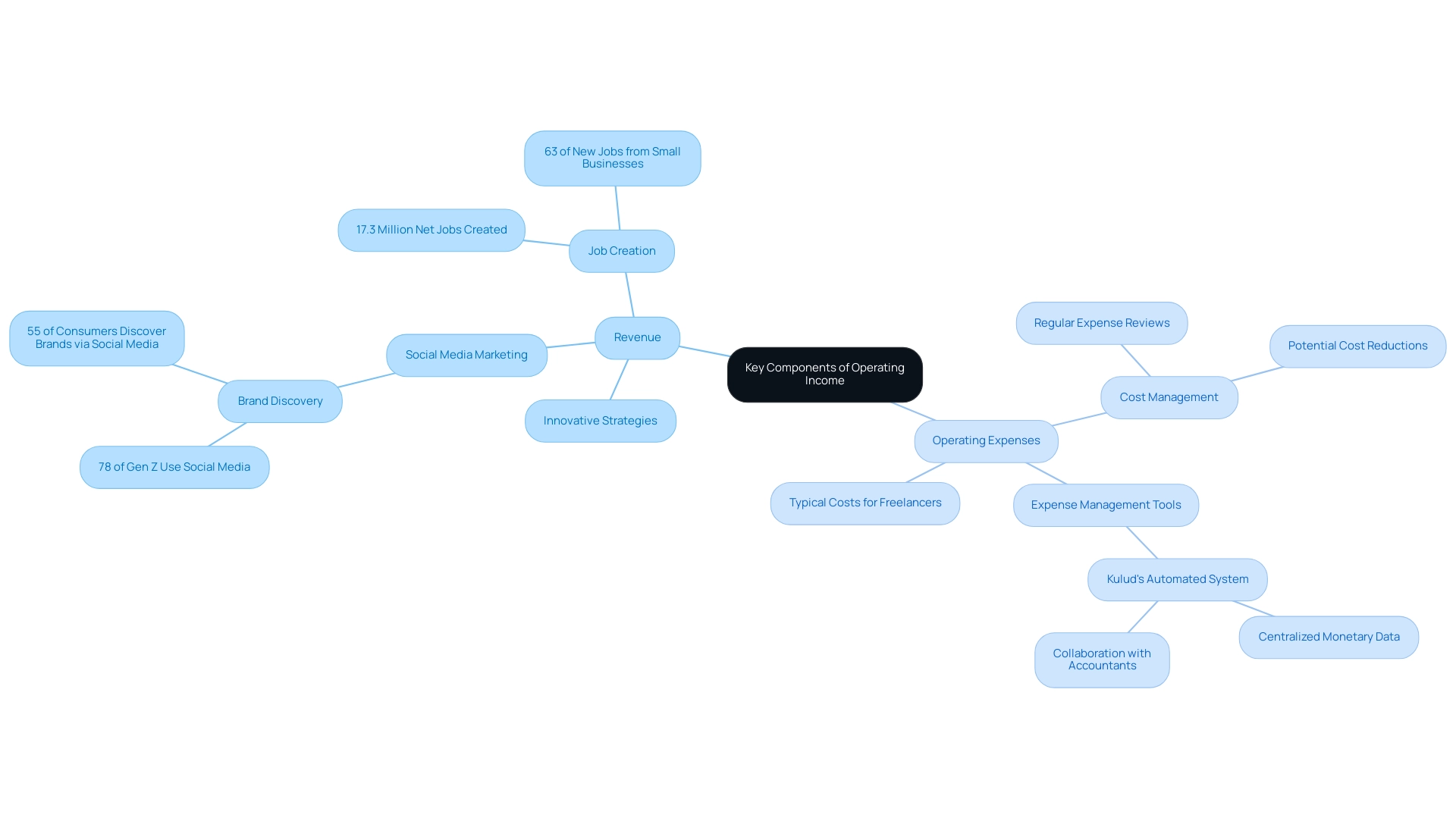
Operating Income vs. Net Income: Key Differences Explained
Operating income and net income are crucial financial metrics that serve distinct purposes in evaluating a business's financial health, particularly for freelancers and small business owners utilizing tools like Kulud.
Operating Income: This metric indicates the profit generated from a company's core business operations, excluding any non-operating income and expenses. It serves as a vital indicator of how effectively an organization is performing in calculating operating income from its primary activities. For example, a small enterprise that produces $200,000 in operational profit demonstrates robust operational efficiency by concentrating on its primary revenue-generating activities. With Kulud, freelancers can automate the categorization of their expenses and easily request missing invoices, ensuring that all relevant data is accurately captured and accounted for, which directly affects their earnings. Additionally, Kulud allows users to export reports in PDF format, further simplifying financial tracking.
Net Profit: Conversely, net profit signifies the overall earnings of an enterprise after all costs have been subtracted, encompassing operating costs, interest, taxes, and any unusual items. This figure provides a comprehensive view of a company's overall profitability. For instance, if the same business incurs $50,000 in interest and taxes, its net profit would total $150,000. This emphasizes the significance of grasping both metrics, as calculating operating income illustrates the broader economic picture. Kulud's capability to align bank transactions with expenses assists freelancers in maintaining a clear perspective on their monetary situation, simplifying cost management and optimizing net profit. Furthermore, Kulud has successfully completed a Cloud Application Security Assessment (CASA), ensuring a high level of security for users' financial data.
Understanding the distinctions between calculating operating income and net earnings is crucial for small business owners. It allows them to focus on enhancing operational efficiency while considering the overall profitability of their ventures. For instance, in April 2023, Microsoft reported an impressive $52.9 billion in revenue, with a quarterly profit of $18.3 billion. However, their substantial expenses, exceeding $30 billion, underscore the need for careful management of both top-line revenue and bottom-line income. This case illustrates how a company can have significant revenue yet still face challenges in profitability due to high expenses.
Moreover, monetary experts emphasize that recognizing these distinctions can significantly impact decision-making. As Michael McCareins observes, "Revenue will appear at the top of a fiscal statement, because it shows the company’s total earnings before any deductions." This understanding underscores the importance for small business proprietors to comprehend how business profit influences performance in relation to net profit, ultimately steering them towards more informed monetary strategies.
Furthermore, analyzing statistics like Macy's selling, general, and administrative expenses (SG&A) of $8.4 billion can offer tangible examples of how expenditures can greatly affect net profit, further emphasizing the significance of these economic metrics. With Kulud, freelancers can simplify their expense management, ensuring they have the tools necessary to enhance both their operations and net earnings.
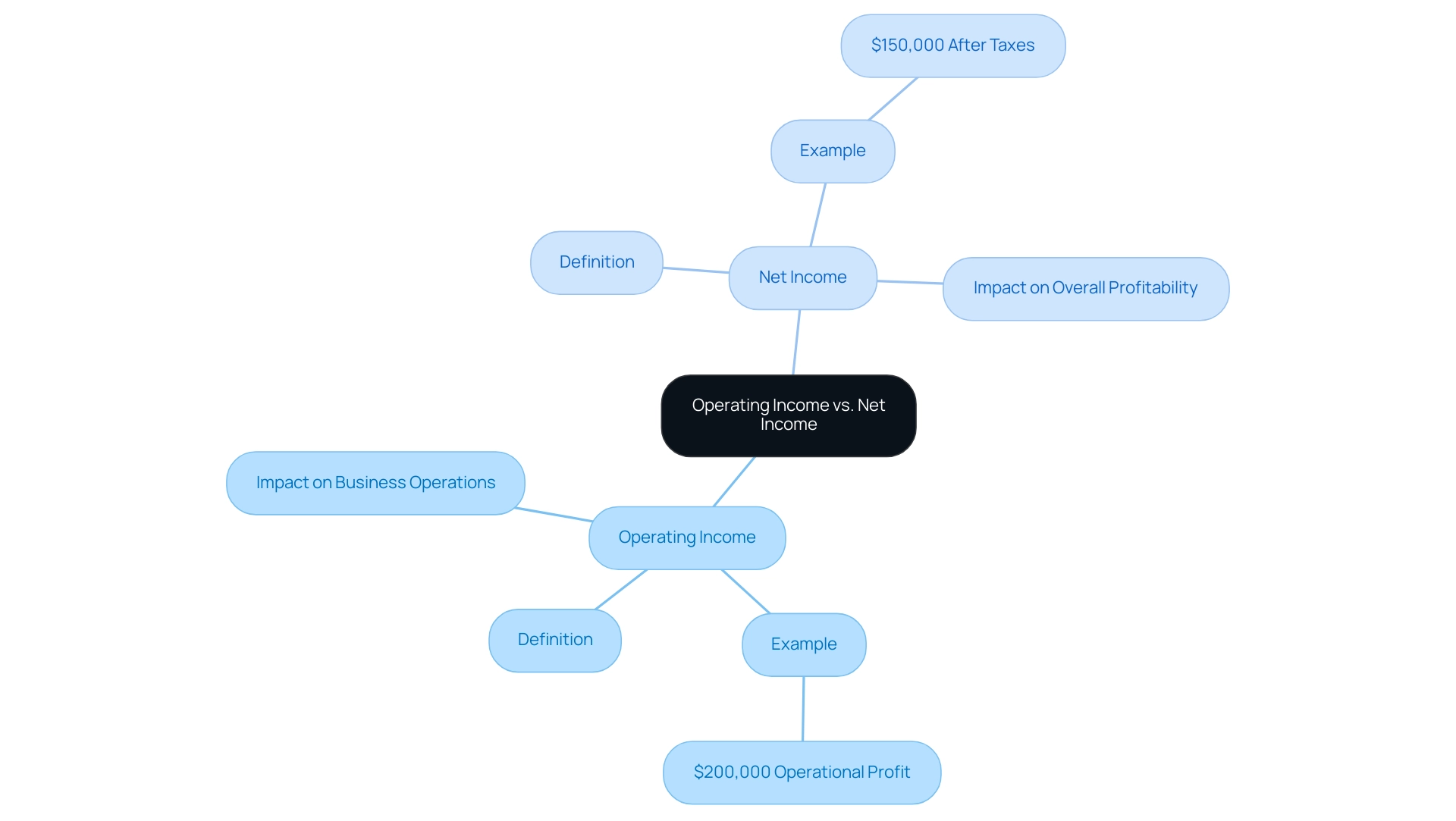
Debunking Myths: Common Misconceptions About Operating Income
Numerous misconceptions about operating income can lead small business owners astray in their financial management.
-
Myth: Operating earnings are the same as net earnings: While both metrics relate to profitability, they serve different purposes. Calculating operating income focuses on the profitability derived from core business operations, excluding non-operating revenue and expenses. In contrast, net profit encompasses all revenues and expenses, including taxes and interest, providing a broader view of a company's financial performance.
-
Myth: High revenue guarantees high profit: A frequent misconception is that increased revenue automatically results in higher profit. However, a company can generate substantial revenue yet report low earnings if its expenses—such as salaries, rent, and utilities—are disproportionately high. This highlights the importance of calculating operating income while managing costs effectively to ensure profitability.
-
Myth: Operational profit is not important for small enterprises: Contrary to this belief, understanding operational profit is essential for small enterprise owners. It acts as a vital indicator of operational efficiency and profitability, enabling informed financial decisions. By concentrating on earnings, owners can pinpoint areas for enhancement and refine their strategies.
Disproving these myths enables small enterprise owners to obtain a clearer understanding of their economic well-being. For example, a small enterprise that understands the difference between gross and net earnings can more effectively evaluate its operational performance and implement strategic changes. Moreover, financial specialists highlight that calculating operating income is crucial for a strong understanding of operational earnings, which can greatly affect decision-making processes, ultimately resulting in enhanced economic results.
In 2025, as the landscape of small enterprises continues to evolve, understanding these nuances becomes increasingly critical. With the number of users engaging with data predicted to rise to 6 billion, or 75% of the global population, economic knowledge, including earnings, is crucial in a swiftly evolving market context. Furthermore, as emphasized by HatchWorks, companies that focus on calculating operating income can realize a productivity boost of 30-50%, illustrating the significance of this metric in improving operational efficiency.
Bill Gates once commented on the importance of technological progress in managing finances, emphasizing the necessity for small enterprise owners to adjust to these changes. Furthermore, the case study on AI as a remedy for labor shortages demonstrates how grasping revenue can assist small enterprises in tackling workforce issues and enhancing their operational approaches.
Kulud has emerged as a game-changer in this context. As Georgi Knyazhev, a freelancer, noted, "Instead of spending 3 hours each month searching for and collecting invoices for my companies in Estonia, I now spend just 5 minutes. It's a huge time saver."
Similarly, Jan Džemesjuk, a creative producer and freelancer, shared, "I just started working as a freelancer and accounting is a big and confusing task for me. I am glad that Kulud helps me with a big part of the bookkeeping process." By optimizing invoice handling and automating bank transaction reconciliation, Kulud enables freelancers and small enterprise owners to centralize their financial data, facilitating a better focus on comprehending and enhancing their operating revenue.
Kulud offers features such as processing 20 invoices and receipts for free, smart reconciliation, and unlimited email processing, which are essential for effective expense management. Addressing these misconceptions, along with leveraging tools like Kulud, can empower owners to navigate their financial journeys with greater confidence and clarity.
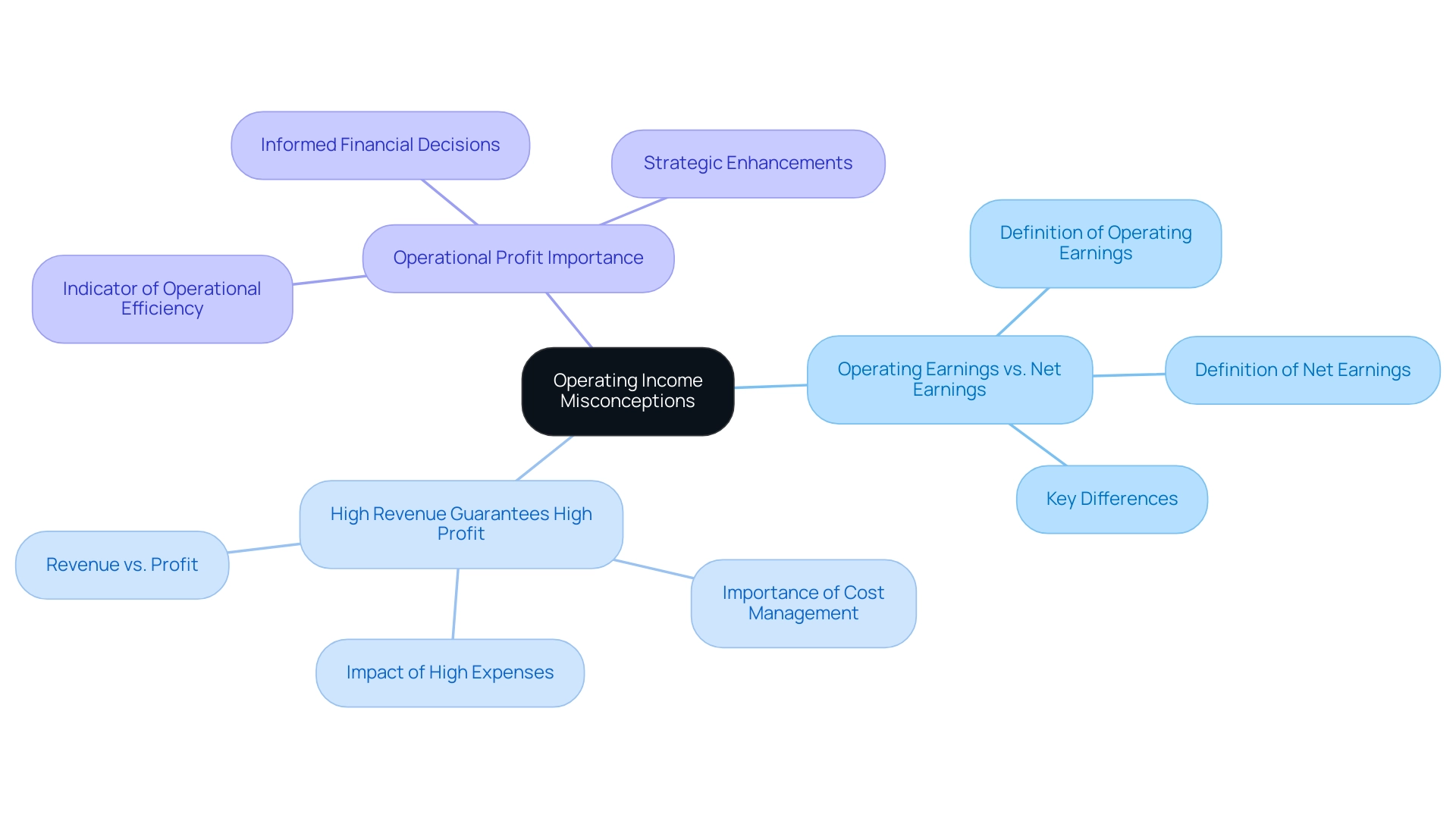
Using Operating Income for Better Business Decisions
For small enterprise owners aiming to make informed and strategic choices, calculating operating income is an essential measure. Understanding this financial indicator can significantly influence decision-making in various aspects of your business.
Performance Assessment: Regularly monitoring your revenue allows you to evaluate the efficiency of your strategies. A consistent decline in operational profits could signal the need for adjustments in operations or a reassessment of your business model. For instance, a recent study highlighted that focusing on operational metrics led to a 30% reduction in production costs per vehicle between 2020 and 2024, alongside a 40% increase in production efficiency.
Budgeting and Forecasting: Calculating operating income from earnings is critical for developing realistic budgets and economic forecasts. By understanding your revenue, you can set achievable financial goals that align with your business's operational capabilities, ensuring your strategies are grounded in reality. Financial Planning and Analysis (FP&A) teams are increasingly prioritizing dynamic planning and forecasting to navigate economic uncertainty and market volatility, making revenue a vital component of these strategies.
Investment Decisions: Investors frequently assess business earnings through the lens of operating income to gauge a company's profitability and operational effectiveness. Strong revenue not only signals a thriving enterprise but also enhances your attractiveness to potential investors, facilitating access to funding options. Notably, 43% of CFOs report being approached for new opportunities more frequently, underscoring the importance of robust financial metrics in forging strategic partnerships.
Cost Management: By calculating operating income, you can scrutinize your business revenue to identify areas where cost reductions are feasible without sacrificing quality. Recognizing inefficiencies enables you to implement strategies that enhance profitability while upholding the standards your customers expect.
Strategic Expansion: Effectively utilizing earnings when calculating operating income is crucial for driving organizational growth. Small enterprises that focus on improving their financial returns often find themselves better positioned to reinvest in their operations, expand their offerings, or explore new markets. For example, Spotify's Work from Anywhere Program demonstrates how operational decisions can impact financial indicators, resulting in a 20% increase in employee satisfaction and a 15% decrease in attrition rates within a year.
Expert Insights: Business strategists emphasize the importance of calculating operating income in decision-making processes. A comprehensive understanding of this metric can empower small enterprise owners to adeptly navigate economic uncertainties and market fluctuations. With 55% of consumers discovering new brands through social media, maintaining a healthy operating income is vital in today's competitive landscape.
By integrating operating income into your decision-making framework, you can enhance your business's financial health and strategic direction, ultimately fostering sustainable growth.
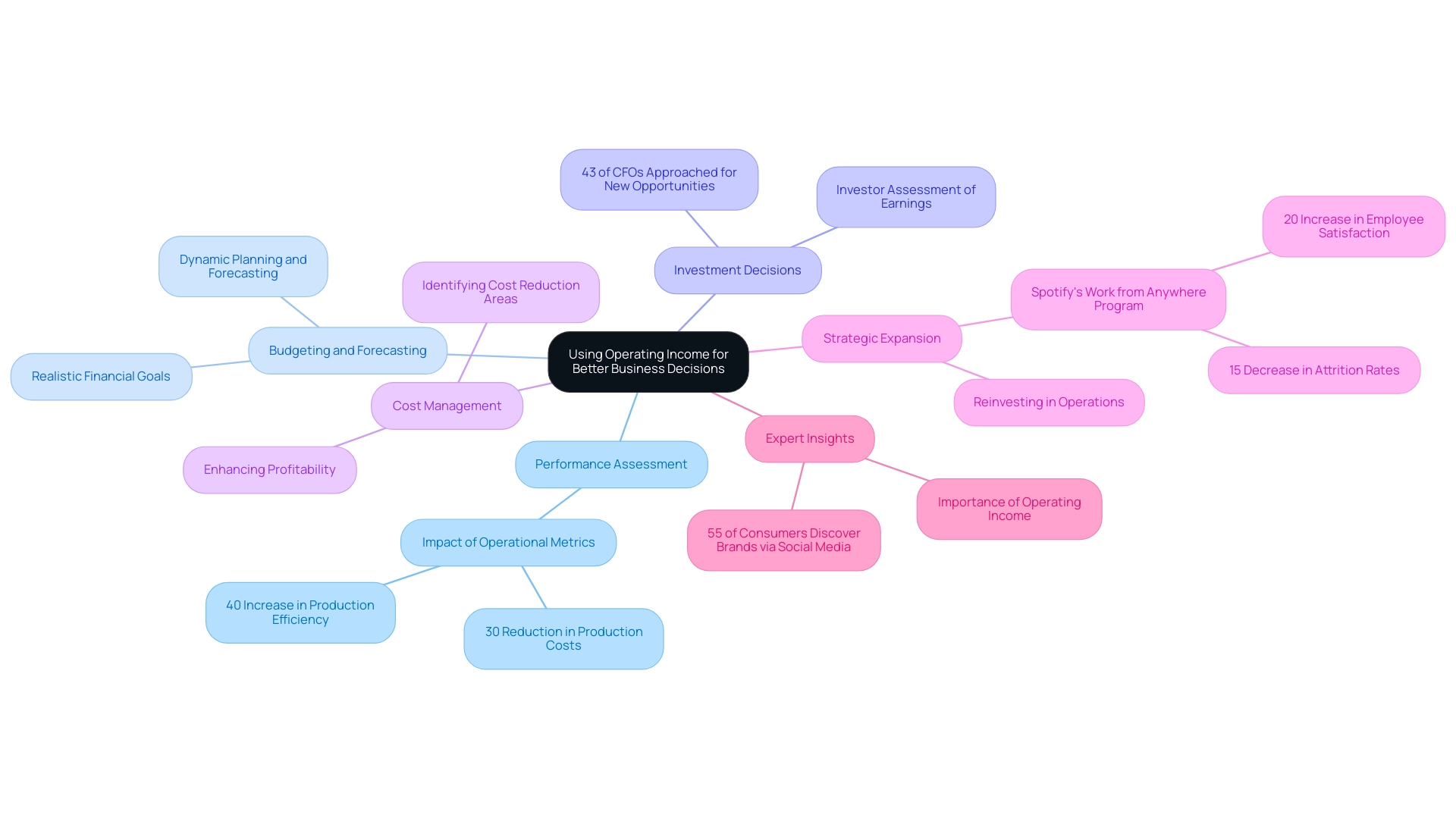
Conclusion
Understanding operating income is essential for small business owners striving for success in a competitive landscape. This metric not only reflects a business's profitability from core operations but also serves as a critical tool for making informed decisions. By accurately calculating operating income and recognizing its components—revenue and operating expenses—business owners can gain valuable insights into their financial health and operational efficiency.
Furthermore, it is important to debunk common misconceptions about operating income. Many may not realize that it differs from net income, and that high revenue does not guarantee high operating income. By leveraging innovative tools like Kulud, small business owners can streamline their financial management processes. This allows them to focus on optimizing their operating income and enhancing overall profitability.
As the business environment continues to evolve, understanding operating income becomes increasingly vital. By regularly tracking this metric, small business owners can evaluate performance, make strategic budgeting decisions, and identify areas for cost management. Ultimately, a strong grasp of operating income empowers entrepreneurs to navigate challenges, attract investors, and drive sustainable growth for their enterprises. Prioritizing this key financial indicator will undoubtedly lead to informed decision-making and long-term success.



